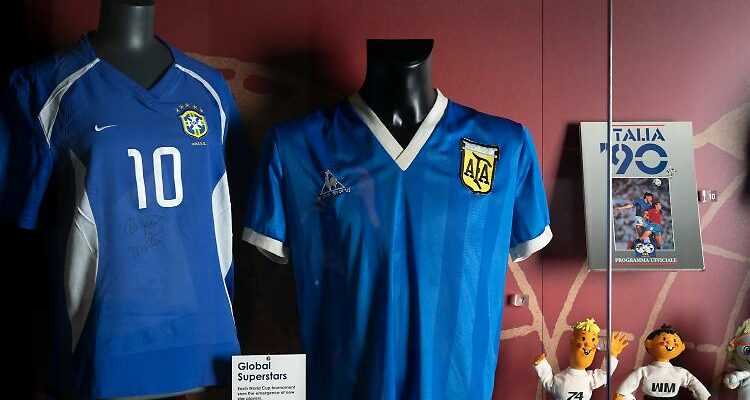Diego Maradona at the 1986 World Cup
“Hand of God” jersey is worth millions of euros
By Roland Peters, Buenos Aires
04/06/2022, 11:16 p.m
In the quarter-finals of the 1986 World Cup, Argentina’s Diego Maradona scored two goals for eternity against England in just a few minutes. The jersey he is wearing is now being auctioned off and is expected to bring in several million euros. It was just improvised.
From April 20, the London auction house Sotheby’s will be accepting bids for a piece of sporting history: Diego Maradona’s shirt, which he wore at the 1986 World Cup during the quarter-finals between Argentina and England. The historic rivalry between the two countries, the circumstances and Maradona himself make the jersey one of the most coveted collectibles in the sport. The company expects the retail price to be around £4 million, or €4.8 million.
So far, the jersey was in a museum in Manchester, England. The owner and seller is the then English national player Steve Hodge, who swapped jerseys with the Argentinian world star, who died in 2020, after his team lost 2-1 (0-0). In it, Maradona had scored both goals for the Argentines. One, from the 55th minute, is known as the ‘Goal of the Century’, in which the midfielder sprinted past four English outfield players in ten seconds over half the pitch and finally duped the goalkeeper. FIFA calls the goal the best goal in football history.
The other goal, four minutes earlier, was also a special one: Maradona scored with his hand. His team-mates had seen it but Maradona urged them to cheer with him. The referee found no violation of the rules. When questioned at the post-match press conference, the Argentine said he scored the goal “a little bit with Maradona’s head and a little bit with the hand of God”. As a result, Maradona led Argentina to the final and there against Germany to the world championship title.
Maradona’s kit was only finalized the night before the quarter-finals game in Mexico City. Because of the heat in Central America – and the day’s play under the blazing sun – Argentina coach Carlos Bilardo had sent his staff to Mexico’s capital to buy an alternative set of kits in a thin fabric. They paid one to two dollars per jersey and sewed on the Argentina FA logo and shirt numbers the night before the game. The Argentines donned the new kits at half-time with the score at 0-0.
“Robbery” in England, War in the Atlantic
The quarter-finals in Mexico were marked by historic rivalry. On the one hand, it was the Argentines’ footballing revenge for the lost quarterfinals at the 1966 World Cup in England, when the German referee Rudolf Kreitlein, in the opinion of the South Americans, allowed himself to be influenced too much by the English public. England took the lead early on, the Argentines complained about being offside. The game was then characterized by many rude fouls.
Maradona’s shirt from the 2nd half of the World Cup quarter-finals against England, here in the museum in Manchester.
(Photo: AP)
The referee eventually dismissed Argentina captain Antonio Rattín. Kreitlein didn’t understand Spanish, Rattín demanded a translator, refused to go and finally had to be taken off the square by the police. England coach Alf Ramsey banned his players from swapping shirts with Argentina after the win, calling their opponents “animals” because of their style of play. The Argentines felt racially discriminated against. They christened the lost quarter-finals “el robo del siglo”, the “robbery of the century”.
At the same time, the revenge was also politically charged. A few years earlier, more than 900 people had died in the Falklands War between Argentina and Great Britain. It was the first game between the two countries since the end of the armed conflict. According to Maradona, the quarter-final victory in Mexico was “revenge” for his fallen compatriots: “It was like we had beaten a country, not just a football team. (…) We knew that they had killed a lot of Argentinian boys, they like had killed little birds.”
